GEORGIA; THE COUNTRY
Chiatura miners’ strike ends after company caves on key demands26 June 2023
By Mariam Nikuradze
Miners concluded their protest outside the parliament on 24 June. Photo: Mariam Nikuradze/OC Media.
A strike by manganese miners in the central Georgian town of Chiatura has come to an end after 18 days, with the mining company agreeing to key demands from the workers.
On Saturday, mining firm Georgian Manganese agreed to reverse new ore quotas that miners had described as ‘inhuman’. They also agreed to honour their contractual obligation to increase salaries by 12%, in line with inflation.
The miners went on strike after the company announced that workers would have to mine up to 40% more ore over shorter shifts. Both miners and labour activists said such demands were impossible to meet and would effectively result in a pay cut for miners.
The mines will resume work from 1 July.
A strike by manganese miners in the central Georgian town of Chiatura has come to an end after 18 days, with the mining company agreeing to key demands from the workers.
On Saturday, mining firm Georgian Manganese agreed to reverse new ore quotas that miners had described as ‘inhuman’. They also agreed to honour their contractual obligation to increase salaries by 12%, in line with inflation.
The miners went on strike after the company announced that workers would have to mine up to 40% more ore over shorter shifts. Both miners and labour activists said such demands were impossible to meet and would effectively result in a pay cut for miners.
The mines will resume work from 1 July.
[Read more on OC Media: ‘Thousands’ of miners go on strike in Chiatura]
The company also agreed to honour their legal obligation to provide paid holidays and sick leave. They also promised to reimburse strike days at 60% pay and to improve safety conditions in the mines.
A commission consisting of representatives of the company, workers, trade unions, and government officials will also be set up to decide on a range of other complaints, including improving health insurance, better safety equipment, and deferring bank loans for employees.
Advertisements
The strike began on 8 June and on 12 June, 10 miners went on a hunger strike. They were joined by an eleventh person several days later who sewed his mouth shut, while another sewed his eyes shut.
As negotiations faltered, a portion of the miners travelled to the capital Tbilisi on 19 June, where four more miners started a hunger strike the next day.
[Read more on OC Media: In pictures | Portrait of a mass hunger strike]
After the deal was reached, Tariel Mikatsadze, one of the striking workers, addressed those gathered outside parliament and reminded those gathered that they were originally demanding a 40% raise.
‘Considering that our friends are on a hunger strike for the 13th day, that we are on strike for the 19th day, we decided to agree to an 11.9% increase according to the inflation’, he said, adding that this proved that increasing their salaries was not their only principal demand.
Several of the protesters outside parliament told OC Media that given that some of the miners were putting their health at risk in the hunger strike, this was the bare minimum they could agree to
Tariel Mikatsadze. Photo: Mariam Nikuradze/OC Media.
Mikatsadze said that it was now crucial to ensure the company also fulfils the remaining demands, which will be discussed in the new commission.
‘If the same thing happens as happened after the mass strike in 2019, if they lie to us again, if they drag these issues over time, we will need your support again’, he added.
The Social Justice Center, a local rights group that assisted the workers during the strike, warned that the agreement did not include certain issues that Georgian Manganese was legally obliged to resolve.
‘Unfortunately, such basic issues as improving the daily meals of miners, restoring the functionality of the sanatorium, resolving loan interest issues with the bank, and renewing equipment to protect labour safety were subjected to commission work.’
‘These issues concern the protection of labour rights at the basic level and they need to be seen in a legal perspective and immediately enforced and ensured’, the statement read.
The miners left Tbilisi on the evening of 24 June, with those who were on a hunger strike transferred to a hospital to recover.
Georgian Manganese also issued a statement confirming that the company would increase raise salaries according to inflation, something they previously agreed to in the collective agreement signed with workers in 2019.
Mikatsadze said that it was now crucial to ensure the company also fulfils the remaining demands, which will be discussed in the new commission.
‘If the same thing happens as happened after the mass strike in 2019, if they lie to us again, if they drag these issues over time, we will need your support again’, he added.
The Social Justice Center, a local rights group that assisted the workers during the strike, warned that the agreement did not include certain issues that Georgian Manganese was legally obliged to resolve.
‘Unfortunately, such basic issues as improving the daily meals of miners, restoring the functionality of the sanatorium, resolving loan interest issues with the bank, and renewing equipment to protect labour safety were subjected to commission work.’
‘These issues concern the protection of labour rights at the basic level and they need to be seen in a legal perspective and immediately enforced and ensured’, the statement read.
The miners left Tbilisi on the evening of 24 June, with those who were on a hunger strike transferred to a hospital to recover.
Georgian Manganese also issued a statement confirming that the company would increase raise salaries according to inflation, something they previously agreed to in the collective agreement signed with workers in 2019.
Why the far right is trying to infiltrate a miners’ strike in Georgia
23 June 2023
By Mariam Nikuradze
Do the miners support the far right?
OC Media collected photos of the far-right figures at the Tbilisi protest and showed them to some of the miners outside parliament to ask if they knew any of these people.
The miners recognised all of them but said they did not know them, and tried to distance themselves from the men.
Indeed, on 20 June, OC Media witnessed far-right campaigner Irakli Khomasuridze telling the miners to distance themselves from friends of Lazare Grigoriadis, the 21-year-old on trial for his role in the March protests. Khomasuridze was heard telling the miners that they were ‘faggots’ and ‘foreign agents’. In response, the miners told Khomasuridze to leave.
We also asked the miners what they thought of Konstantine Morgoshia, one of the leaders of Alt Info, who wrote on Facebook expressing support for the strike.
‘He is also one of those swine businessmen, yes’, one of them responded.
‘He is the leader of [Alt Info] and we are calling everyone to do business in the correct way. But a person like him, how can he stand next to us when he is doing the same [as the mining company]?’
‘We try not to get such people close to us’, he added.
Salome Shubladze is the director of social policy at a local rights group, the Social Justice Centre. The centre has long advocated for the miners in Chiatura and elsewhere in the country, and provides legal aid to them.
Shubladze told OC Media that she also noticed members of Alt Info at the miners’ protests, recalling one instance in which they criticised young people for their appearance.
‘They told them: “why are you wearing an earring, believe in Christ”. They responded that they came to express solidarity, but this man told them to believe in Christ first’, she recalled.
She said that the young people then asked the miners if they knew who this person was, which they said they didn’t.
The incident was one of those recounted by Lucas Ablotia that deterred him and his friends from continuing to attend the miners’ strike.
‘There was aggression towards others too’, he said, ‘including one person with earrings; they said they wouldn’t allow men with earrings close, that they’d beat them. There were threats like this towards people who looked different, who had dyed hair or colourful accessories. They kicked out many people very aggressively.’
Shubladze added that this was not the first time far-right groups had attached themselves to such protests, recalling the Namakhvani HPP dam protests.
‘Alt Info were chasing after young people who were not necessarily dressed in a conventional way. We see the same thing here’, she said.
And unlike the young people, who did not express any motivation other than solidarity for joining with the miners, ‘chasing after young people’ certainly seems to have been a primary motivation for the far right.
Giorgi Odzelashvili, one of the far-right campaigners spotted at the protest, posted a photo on Facebook on 19 June of a young man with a rainbow bag. It is unclear if the photo was even taken during the miners’ protest, but Odzelashvili claimed it was, stating that there were ‘a lot of faggots’ gathered there.
He urged supporters to join him while hinting at his violent intentions, telling his followers they should not be surprised if he were arrested.
Disappointment
The conflicts has left many of the miners distrustful of everyone and anyone without a personal connection to Chiatura.
Time and again, the miners who spoke to OC Media said their goal was simply to realise their right to just and dignified employment.

By Mariam Nikuradze
Mariam is a veteran journalist with over 10 years experience under her belt. She is passionate about gender equality and workers’ rights. Despite now being shackled behind a desk for most of the time, she can never sit still when something is happening and always goes to report from the ground. Mari lives with her cat Willie, who she is training to be a dog.
23 June 2023
By Mariam Nikuradze
A group of striking miners from Chiatura outside the parliament building in Tbilisi. Photo: Mariam Nikuradze/OC Media.
Manganese miners from the central Georgian town of Chiatura have for weeks been on strike over their working conditions. But since a portion of the strikers moved their protest to the capital Tbilisi, far-right figures have been seen attempting to ingratiate themselves into the protests, leaving the miners unsure who to trust.
When several dozen striking miners and their supporters arrived in Tbilisi on 19 June, their intention was to bring wider attention to their cause. And the strike resonated with many Georgians, especially as images of miners who had sewn shut their mouths in despair emerged.
Some of those to join their demonstration in solidarity were young people who previously protested, and defeated, the government’s planned foreign agent law.
One was Lucas Ablotia. Along with several of his friends, Ablotia was outside the parliament demonstrating in support of Lazare Grigoriadis when the miners arrived in Tbilisi.
‘We learned that miners were protesting inhuman treatment, including violations of labour rights. Obviously, I wanted to express solidarity and would stand with them as a citizen’, Ablotia told OC Media.
Ablotia was draped in an EU flag and held Georgian and Ukrainian flags. ‘We always stand at protests like this’, he said.
Advertisements
But Ablotia and his friends weren’t welcomed with open arms.
‘Several people approached me and spoke to me in a bad tone, that I was ruining this protest because I stood with the EU flag, that the EU is depraved, that Ukraine started the war and it’s Ukraine’s fault what is happening in Ukraine.’
‘They accused me of being a supporter of Misha [former President Mikheil Saakashvili]. They told me that Misha started the war in 2008, and things like that.’
‘It is not safe to be there anymore. They threaten us, they yell at us. They told me I am a Mishisti faggot and things like this.’
In the following days, the young people did not attend the miners’ demonstration.
But Ablotia is not sure who it was that was harassing them. At least one was scolding them ‘in the name of the miners’, he said.
‘We spotted some fascist groups there’, he added.
Extremists at the picket line
While following the miners’ strike in Tbilisi, OC Media identified at least five people affiliated with the far-right extremist group Alt Info hanging around the protest. On several occasions, we overheard them attempting to discredit the young people present, often using homophobic language.
One was Giorgi Odzelashvili, who marched with the miners from parliament to the offices of the mining firm, Georgian Manganese.
Odzelashvili participated in the attack on the Tbilisi Pride office during the 5 July 2021 homophobic riots. He is active on Facebook, especially on a page called ‘Conscience Boys’, which advocates for the release of the handful of people arrested over the 5 July violence.
Manganese miners from the central Georgian town of Chiatura have for weeks been on strike over their working conditions. But since a portion of the strikers moved their protest to the capital Tbilisi, far-right figures have been seen attempting to ingratiate themselves into the protests, leaving the miners unsure who to trust.
When several dozen striking miners and their supporters arrived in Tbilisi on 19 June, their intention was to bring wider attention to their cause. And the strike resonated with many Georgians, especially as images of miners who had sewn shut their mouths in despair emerged.
Some of those to join their demonstration in solidarity were young people who previously protested, and defeated, the government’s planned foreign agent law.
One was Lucas Ablotia. Along with several of his friends, Ablotia was outside the parliament demonstrating in support of Lazare Grigoriadis when the miners arrived in Tbilisi.
‘We learned that miners were protesting inhuman treatment, including violations of labour rights. Obviously, I wanted to express solidarity and would stand with them as a citizen’, Ablotia told OC Media.
Ablotia was draped in an EU flag and held Georgian and Ukrainian flags. ‘We always stand at protests like this’, he said.
Advertisements
But Ablotia and his friends weren’t welcomed with open arms.
‘Several people approached me and spoke to me in a bad tone, that I was ruining this protest because I stood with the EU flag, that the EU is depraved, that Ukraine started the war and it’s Ukraine’s fault what is happening in Ukraine.’
‘They accused me of being a supporter of Misha [former President Mikheil Saakashvili]. They told me that Misha started the war in 2008, and things like that.’
‘It is not safe to be there anymore. They threaten us, they yell at us. They told me I am a Mishisti faggot and things like this.’
In the following days, the young people did not attend the miners’ demonstration.
But Ablotia is not sure who it was that was harassing them. At least one was scolding them ‘in the name of the miners’, he said.
‘We spotted some fascist groups there’, he added.
Extremists at the picket line
While following the miners’ strike in Tbilisi, OC Media identified at least five people affiliated with the far-right extremist group Alt Info hanging around the protest. On several occasions, we overheard them attempting to discredit the young people present, often using homophobic language.
One was Giorgi Odzelashvili, who marched with the miners from parliament to the offices of the mining firm, Georgian Manganese.
Odzelashvili participated in the attack on the Tbilisi Pride office during the 5 July 2021 homophobic riots. He is active on Facebook, especially on a page called ‘Conscience Boys’, which advocates for the release of the handful of people arrested over the 5 July violence.
Giorgi Odzelashvili at the miners’ strike in Tbilisi on 20 June (left, photo: Mariam Nikuradze/OC Media) and attacking the offices of Tbilisi Pride on 5 July 2021
(Photo: Euronews Georgia).
Another is Irakli Khomasuridze, a familiar face at violent far-right demonstrations.
In June 2022 Khomasuridze was convicted of attacking liberal politicians Khatuna Samnidze and Davit Berdzenishvili. He also threatened OC Media’s director and journalist, Mariam Nikuradze, at a protest outside Tbilisi City Court where some of those arrested over the 5 July violence were on trial.
Another is Irakli Khomasuridze, a familiar face at violent far-right demonstrations.
In June 2022 Khomasuridze was convicted of attacking liberal politicians Khatuna Samnidze and Davit Berdzenishvili. He also threatened OC Media’s director and journalist, Mariam Nikuradze, at a protest outside Tbilisi City Court where some of those arrested over the 5 July violence were on trial.
Irakli Khomasuridze at the miners’ protest on 20 June 2023 (left) and outside the Tbilisi City Court in April 2022, protesting the conviction of people arrested for 5 July violence. Photos: Mariam Nikuradze/OC Media.
Zaza Mchedlidze, who was convicted of attacking journalists on 5 July, was also spotted at the miners’ protest.
Zaza Mchedlidze, who was convicted of attacking journalists on 5 July, was also spotted at the miners’ protest.
Zaza Mchedlidze at miners’ protest (left) and during the 5 July pogroms.
Photos: Natia Amiranashvili/Publika, Tabula.
Gocha Surameli and Ramin Abesadze, both affiliated with Alt Info, were also present at the miners’ protest. Both were broadcasting live coverage and interviewing some of the miners. Gocha Surameli at the miners’ strike in Tbilisi (left, photo: Mariam Nikuradze/OC Media) and posing with the ‘Conscience Boys’ advocating the release of people arrested for the 5 July riots (image via Facebook).
Gocha Surameli at the miners’ strike in Tbilisi (left, photo: Mariam Nikuradze/OC Media) and posing with the ‘Conscience Boys’ advocating the release of people arrested for the 5 July riots (image via Facebook).
Gocha Surameli and Ramin Abesadze, both affiliated with Alt Info, were also present at the miners’ protest. Both were broadcasting live coverage and interviewing some of the miners.
 Gocha Surameli at the miners’ strike in Tbilisi (left, photo: Mariam Nikuradze/OC Media) and posing with the ‘Conscience Boys’ advocating the release of people arrested for the 5 July riots (image via Facebook).
Gocha Surameli at the miners’ strike in Tbilisi (left, photo: Mariam Nikuradze/OC Media) and posing with the ‘Conscience Boys’ advocating the release of people arrested for the 5 July riots (image via Facebook).Ramin Abesadze at the miners’ protest (left) and campaigning for the far-right Georgian Idea Party. Photos via Facebook.
Prominent far-right campaigner Guram Palavandishvili was also spotted by others at the miners’ demonstration.
Prominent far-right campaigner Guram Palavandishvili was also spotted by others at the miners’ demonstration.
Guram Palavandishvili at the miners’ protest and on 6 July 2021 at a homophobic protest.
Photos: Lucas Ablotia and Mariam Nikuradze/OC Media.
Do the miners support the far right?
OC Media collected photos of the far-right figures at the Tbilisi protest and showed them to some of the miners outside parliament to ask if they knew any of these people.
The miners recognised all of them but said they did not know them, and tried to distance themselves from the men.
Indeed, on 20 June, OC Media witnessed far-right campaigner Irakli Khomasuridze telling the miners to distance themselves from friends of Lazare Grigoriadis, the 21-year-old on trial for his role in the March protests. Khomasuridze was heard telling the miners that they were ‘faggots’ and ‘foreign agents’. In response, the miners told Khomasuridze to leave.
We also asked the miners what they thought of Konstantine Morgoshia, one of the leaders of Alt Info, who wrote on Facebook expressing support for the strike.
‘He is also one of those swine businessmen, yes’, one of them responded.
‘He is the leader of [Alt Info] and we are calling everyone to do business in the correct way. But a person like him, how can he stand next to us when he is doing the same [as the mining company]?’
‘We try not to get such people close to us’, he added.
Salome Shubladze is the director of social policy at a local rights group, the Social Justice Centre. The centre has long advocated for the miners in Chiatura and elsewhere in the country, and provides legal aid to them.
Shubladze told OC Media that she also noticed members of Alt Info at the miners’ protests, recalling one instance in which they criticised young people for their appearance.
‘They told them: “why are you wearing an earring, believe in Christ”. They responded that they came to express solidarity, but this man told them to believe in Christ first’, she recalled.
She said that the young people then asked the miners if they knew who this person was, which they said they didn’t.
The incident was one of those recounted by Lucas Ablotia that deterred him and his friends from continuing to attend the miners’ strike.
‘There was aggression towards others too’, he said, ‘including one person with earrings; they said they wouldn’t allow men with earrings close, that they’d beat them. There were threats like this towards people who looked different, who had dyed hair or colourful accessories. They kicked out many people very aggressively.’
Shubladze added that this was not the first time far-right groups had attached themselves to such protests, recalling the Namakhvani HPP dam protests.
‘Alt Info were chasing after young people who were not necessarily dressed in a conventional way. We see the same thing here’, she said.
And unlike the young people, who did not express any motivation other than solidarity for joining with the miners, ‘chasing after young people’ certainly seems to have been a primary motivation for the far right.
Giorgi Odzelashvili, one of the far-right campaigners spotted at the protest, posted a photo on Facebook on 19 June of a young man with a rainbow bag. It is unclear if the photo was even taken during the miners’ protest, but Odzelashvili claimed it was, stating that there were ‘a lot of faggots’ gathered there.
He urged supporters to join him while hinting at his violent intentions, telling his followers they should not be surprised if he were arrested.
Disappointment
The conflicts has left many of the miners distrustful of everyone and anyone without a personal connection to Chiatura.
Time and again, the miners who spoke to OC Media said their goal was simply to realise their right to just and dignified employment.
Thousands of miners are on strike in Chiatura over their work conditions, with a handful having gone on hunger strike.
The striking workers have organised daily marches through Chiatura.
Photo: Mariam Nikuradze/OC Media.
They said that many people had come to them, sometimes with pictures, sometimes with stories about specific people, telling them that they should avoid them. As a result, they no longer knew who to believe.
‘In the end, we decided not to let anyone close to our tribune. No one will be able to stand at the microphone except us’, one of them said.
Despite the confusion, they said they still wanted support.
‘We want many people to come and we want to let these people understand our problems as clearly as possible’, they said.
But the far-right presence has had an impact, with Ablotia and others saying they no longer felt safe attending.
The Social Justice Centre’s Salome Shubladze echoed suspicions among some that this may have been the point all along.
‘Obviously, when there are violent groups at a protest, some people will avoid going.’
While she said there was not enough evidence to link these groups directly to the government, it was visible that Alt Info’s goals were often in unison with those of the government.
‘This is why we do not rule out that this group is being used to weaken and divide the protest, and to fragment and remove the support which this protest still has.’
For now, as their strike continues unabated, many of the miners have been left disillusioned with their journey to the capital.
Giorgi Kupatadze, who had sewed his eyes shut as part of the strike because he ‘doesn’t want to watch this injustice anymore’, arrived in Tbilisi to join the protest on 20 June. He left the next day, stating that he had hoped to gain more attention to their plight.
‘I am leaving this place very heartbroken’, Publika cited him as saying.
They said that many people had come to them, sometimes with pictures, sometimes with stories about specific people, telling them that they should avoid them. As a result, they no longer knew who to believe.
‘In the end, we decided not to let anyone close to our tribune. No one will be able to stand at the microphone except us’, one of them said.
Despite the confusion, they said they still wanted support.
‘We want many people to come and we want to let these people understand our problems as clearly as possible’, they said.
But the far-right presence has had an impact, with Ablotia and others saying they no longer felt safe attending.
The Social Justice Centre’s Salome Shubladze echoed suspicions among some that this may have been the point all along.
‘Obviously, when there are violent groups at a protest, some people will avoid going.’
While she said there was not enough evidence to link these groups directly to the government, it was visible that Alt Info’s goals were often in unison with those of the government.
‘This is why we do not rule out that this group is being used to weaken and divide the protest, and to fragment and remove the support which this protest still has.’
For now, as their strike continues unabated, many of the miners have been left disillusioned with their journey to the capital.
Giorgi Kupatadze, who had sewed his eyes shut as part of the strike because he ‘doesn’t want to watch this injustice anymore’, arrived in Tbilisi to join the protest on 20 June. He left the next day, stating that he had hoped to gain more attention to their plight.
‘I am leaving this place very heartbroken’, Publika cited him as saying.

By Mariam Nikuradze
Mariam is a veteran journalist with over 10 years experience under her belt. She is passionate about gender equality and workers’ rights. Despite now being shackled behind a desk for most of the time, she can never sit still when something is happening and always goes to report from the ground. Mari lives with her cat Willie, who she is training to be a dog.
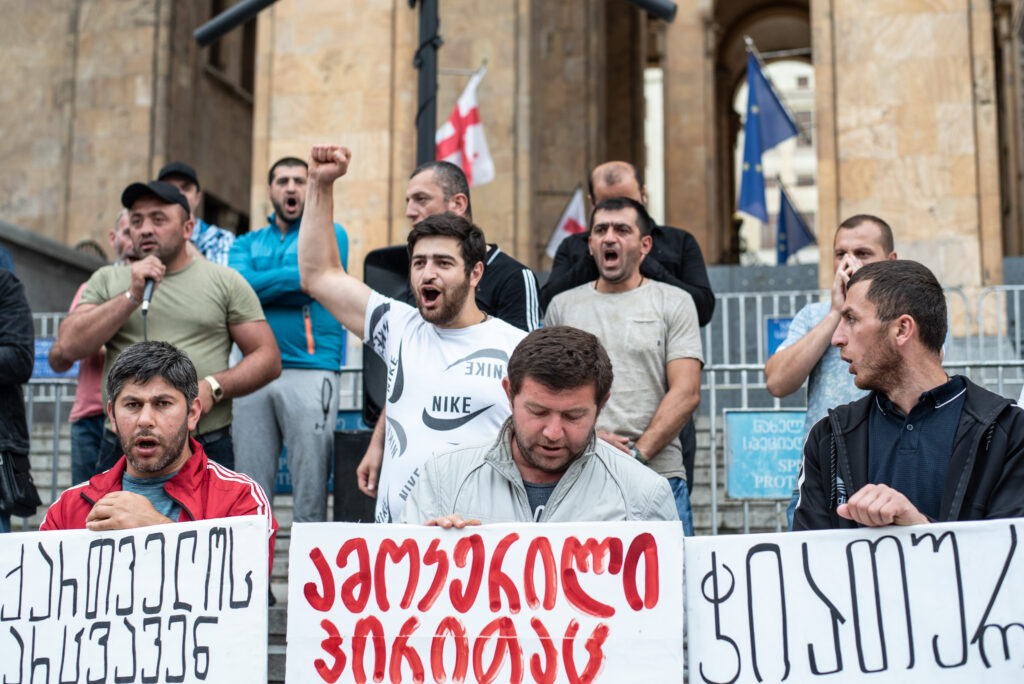
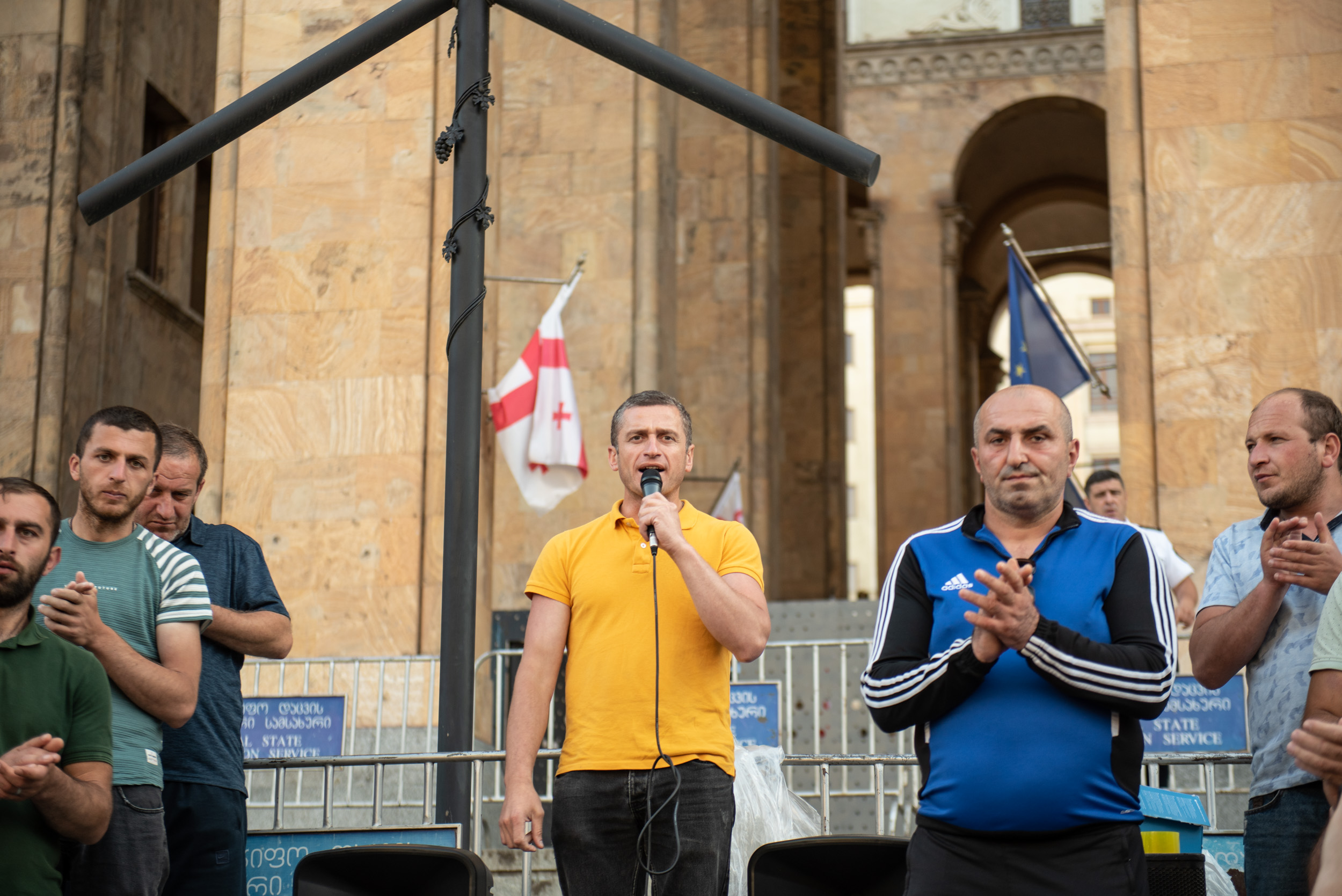
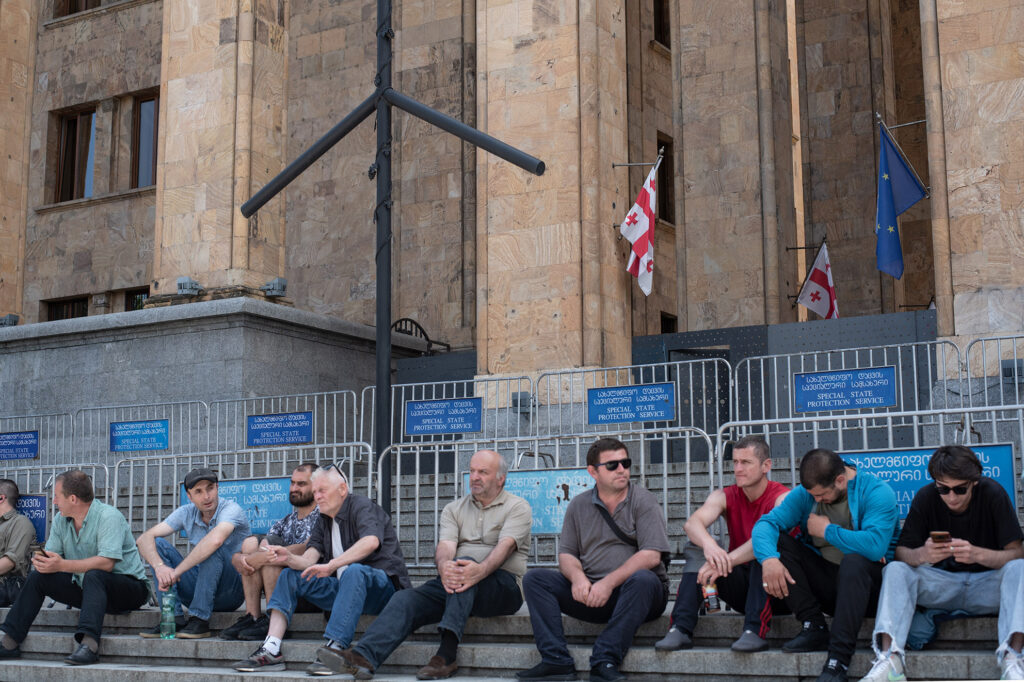
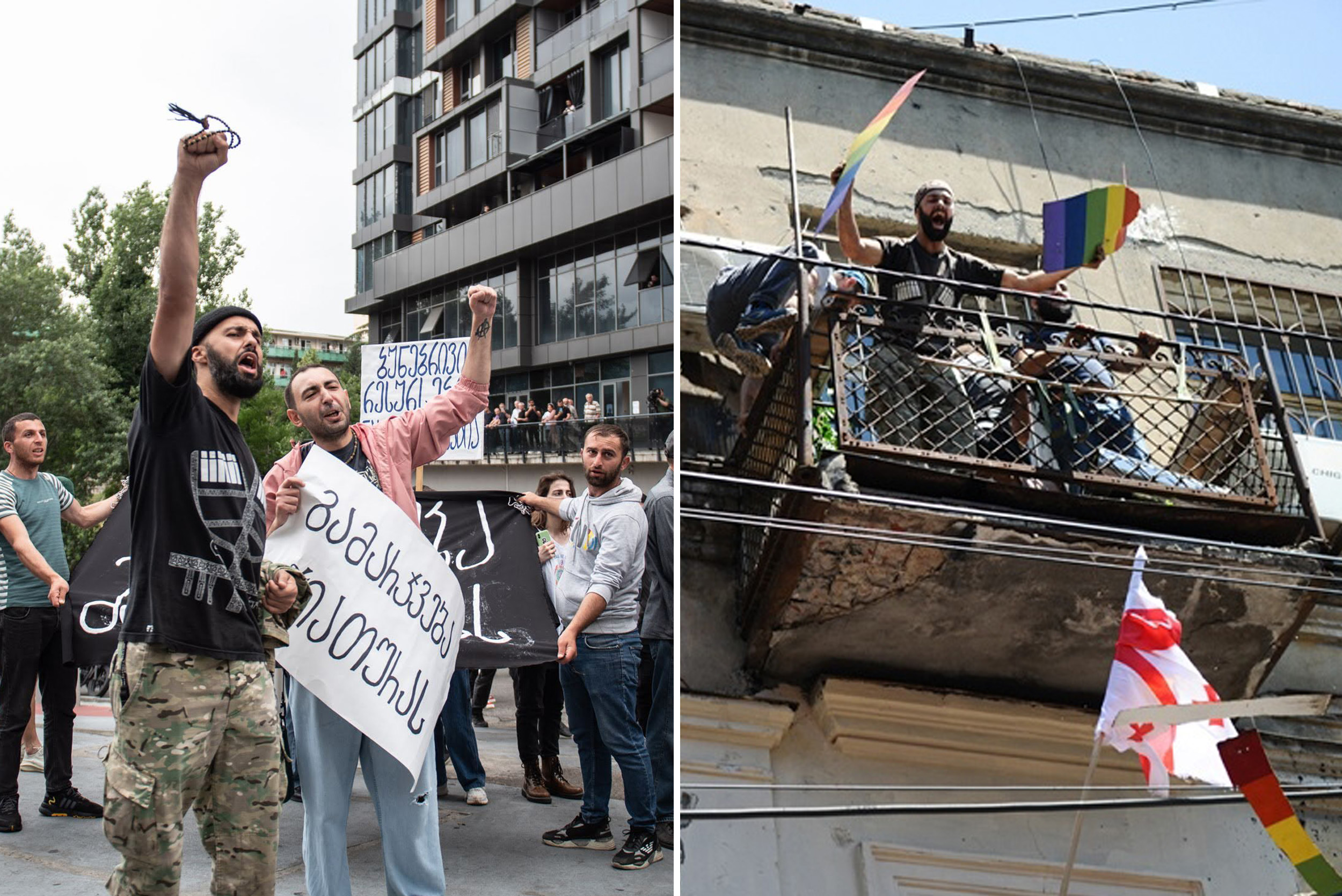
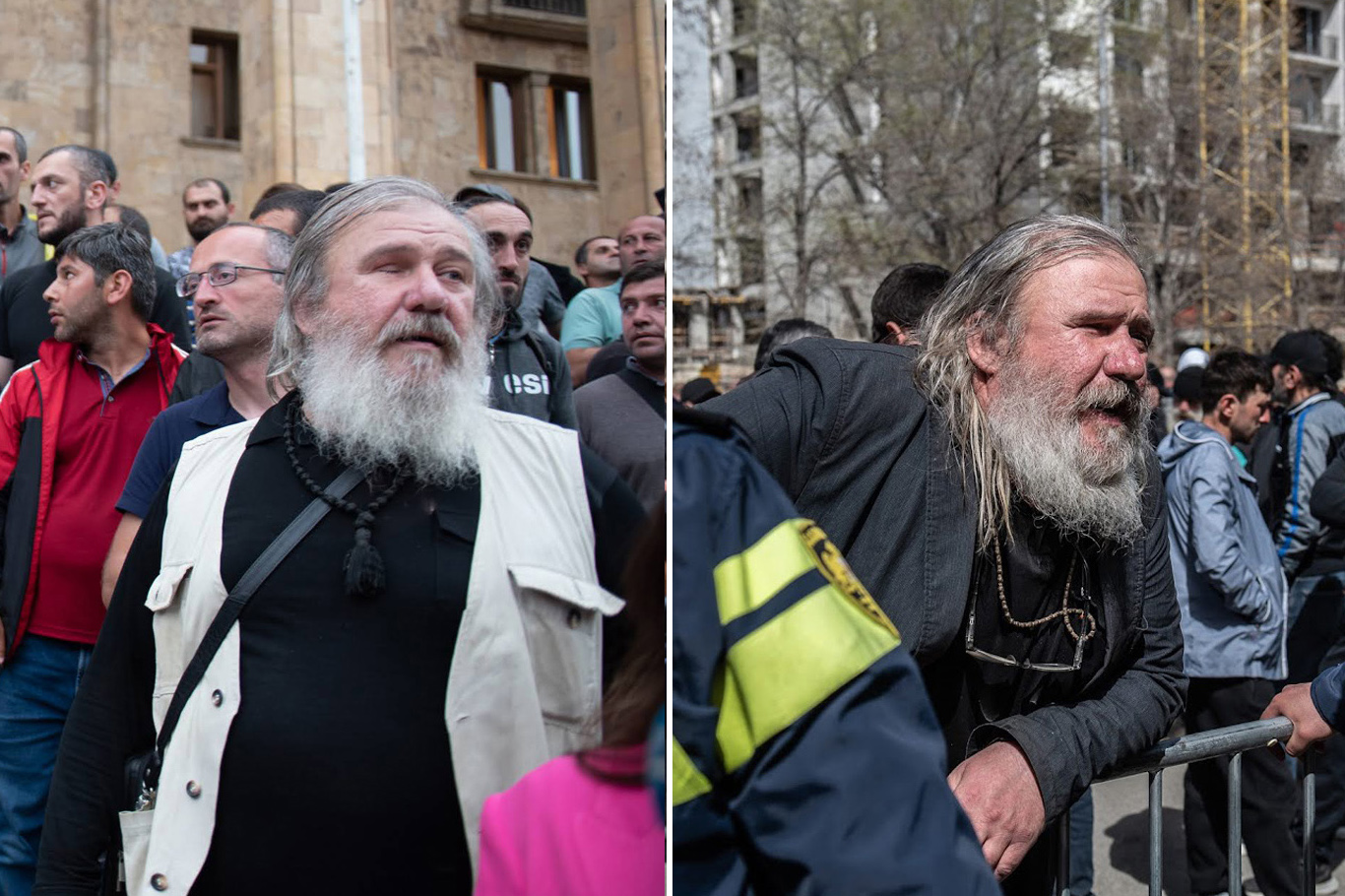



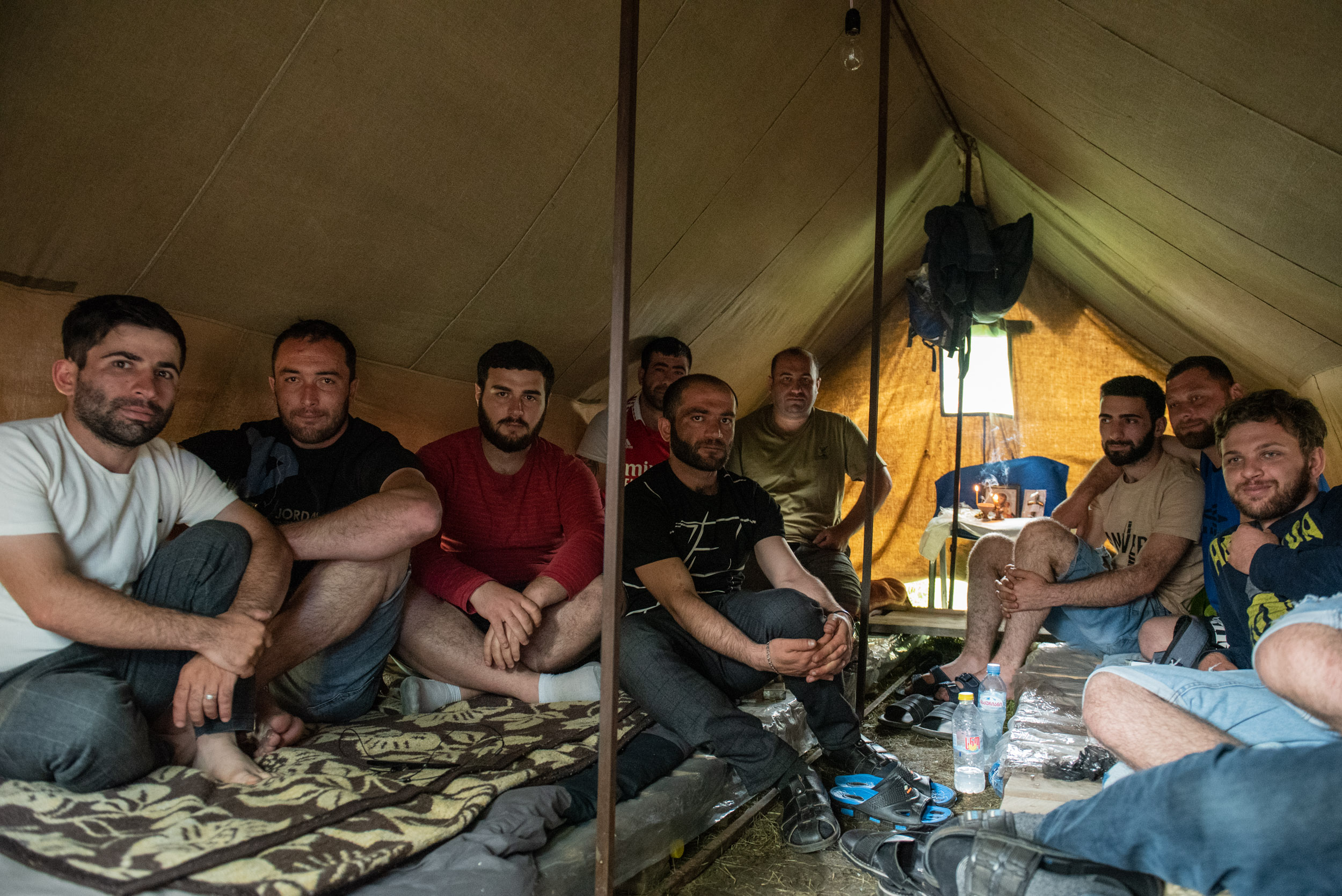
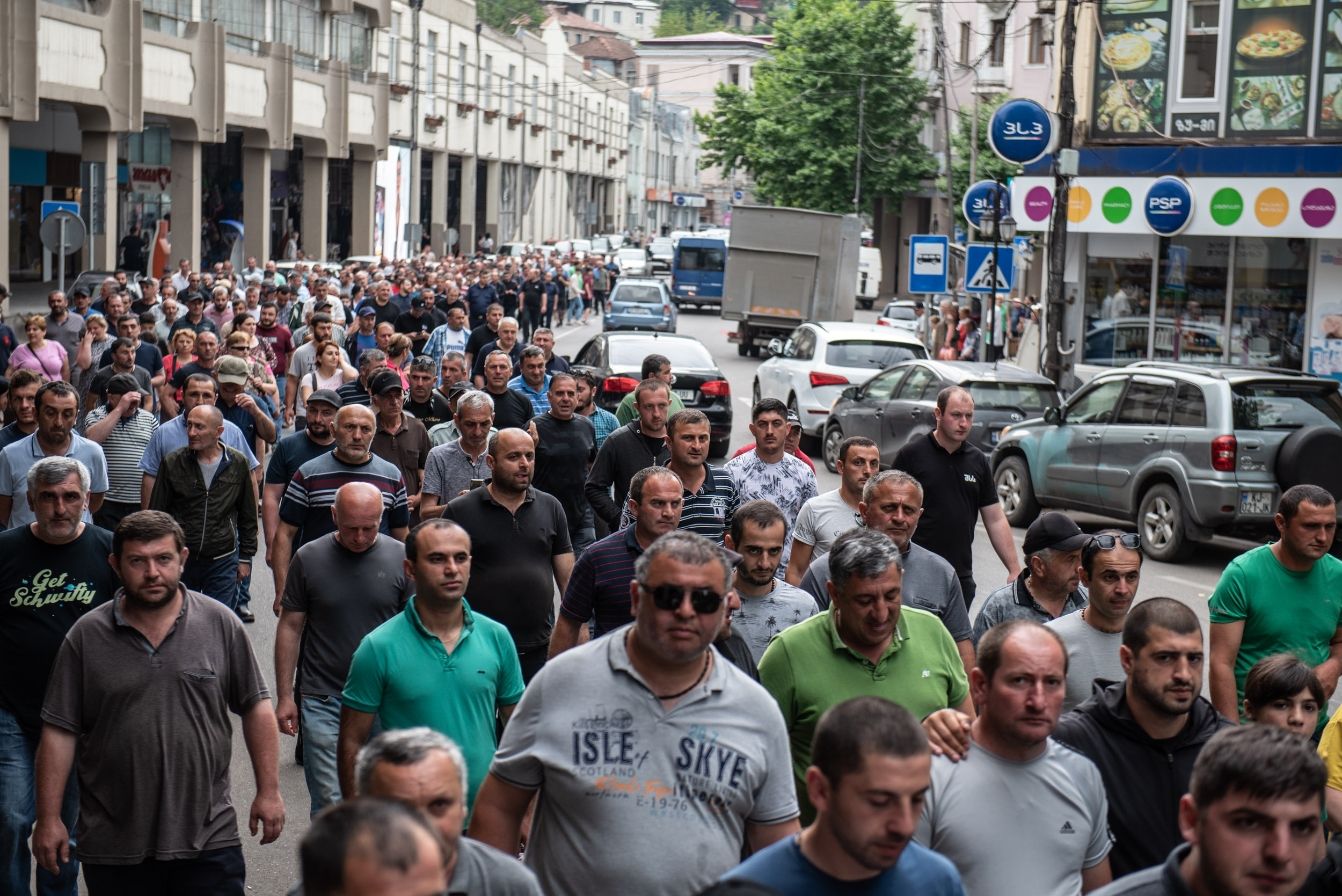



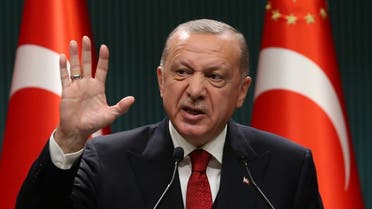






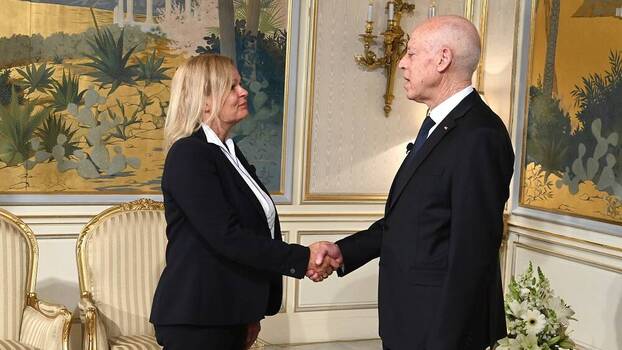 Tunisian President Kais Saïed shakes hands with visiting German Interior Minister Nancy Faeser at the Carthage Palace in Tunis, Tunisia, 19 June 2023.Photo: IMAGO / Xinhua
Tunisian President Kais Saïed shakes hands with visiting German Interior Minister Nancy Faeser at the Carthage Palace in Tunis, Tunisia, 19 June 2023.Photo: IMAGO / Xinhua




